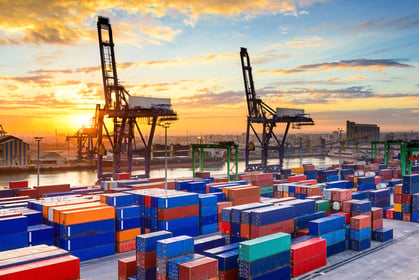5 Steps for Optimizing Your Shipping Routes
Brian Hoey - May 14, 2019

Once you send a finished product out into the world, it sometimes feels like you’re no longer in control of it—whether or not it reaches its final destination is a matter of preparation and luck. Even if you’re a shipper or freight forwarder, the routes that any piece of freight might take through the global supply chain sometimes seem too chaotic to optimize. There’s good reason to feel this way, but in the era of Logistics 4.0 there’s also reason to hope. Digital shipping and forwarding workflows are adding new degrees of sophistication to route planning processes, and giving logistics planners new opportunities to reduce costs and optimize their shipping flows.
That said, new efficiencies don’t come about on their own. That’s why we’ve assembled a few tips that supply chain managers can use for optimizing the journeys that their products take to their final destinations.
1. Embrace Change
Now, there are some who would have you believe that the best plan is the one created the farthest in advance—that by settling on your preferred route early you can lock in the best price and save yourself the confusion of planning at the last minute. While it’s true that securing optimal rates with your various supply chain partners is a concern, it may be outweighed by (and often compatible with) the need to remain flexible. The conditions of the global supply chain change rapidly, and by relying on static, well-established shipping routes you simultaneously leave yourself open to disruptions and cut yourself off from new sources of value. Instead of picking a route well in advance and hoping that conditions stay the same, you should wait until all of the relevant information reveals itself: you might find that you can take advantage of backhauls that you didn’t know about, or that new customer orders would make it possible to bundle shipments in a more cost effective manner. Finding the optimal moment to actually secure your route can be a tough balancing act, but the potential upside is increased flexibility.
2. Anticipate Customer Needs
Another suggestion that sometimes gets lobbed at logistics planners is that, by lengthening their lead times, they could perform route planning activities more effectively. This would almost certainly be effective, more time can certainly be translated into better plans, if it were feasible. But as customer expectations for shipping turnarounds get more and more exacting, how many companies can ensure standard two-three day shipping times for customer orders while simultaneously lengthening lead times? Our guess is that it’s not very many, which means that planners need to look elsewhere for the benefits that come from all that added time. To wit, supply chain managers can give themselves a lot more breathing room to make optimal decisions if they can get better at predicting the needs of their customers in advance. This will likely require serious efforts in the way of collecting and analyzing customer data, but with advanced analytics you can leverage whatever information you may have into robust demand forecasts. From there, it’s possible to generate longer term plans to which you can make small adjustments as any operational shifts occur.
3. Utilize Mode Shifts
Multimodal shipping—i.e. changing modes of transport during a shipment and potentially repackaging your cargo in the process—isn’t a new concept. In fact, it’s been around since the dawn of shipping. While it’s easy to treat it as an inconvenient fact of life (“wouldn’t it be better to be able to stick with just air freight or just a container ship for the whole route?” you might ask), it’s increasingly presenting itself to savvy supply chain managers as a way to add value. How? By offering logistics planners the ability to re-bundle their shipments after the fact in order to maximize efficiency. If, for instance, you’re sending out a few less-than-full truckloads (LTLs) because of the particular strictures placed on your various warehouses and timelines, but they’re all scheduled to cross paths, you can use multimodal shipping as an excuse to turn your LTLs into an FTL before they reach their final destination, saving on labor and fuel costs. This, too, requires a high degree of visibility into your operations, because you need to be able to identify and take advantage of these opportunities as they emerge.
4. Track in Real Time
Speaking of visibility. In a Logistics 4.0 environment, each element of your transport network should be interconnected, meaning that every truck, shipping container, and pallet should be in communication with one another and with your central logistics control tower. For all of the other ways that this can help you to optimize your logistics processes, it should also pave the way for real-time monitoring of your transport logistics. Why is this useful for optimization? Well, for starters, it helps make it possible for logistics planners to take the advice that we’ve doled out above. Beyond that, however, real-time can be one of the most important tools in the supply chain manager’s toolkit when it comes to warding off disruptions and breakdowns. After all, if you can monitor every situation as it’s unfolding, you’ll be much more likely to identify warning signs in advance and take steps to manage the probability of, say, a late shipment due to poor traffic and weather or a missed opportunity for cargo consolidation.
5. Integrate with Your Shipping Partners
So far, we’ve mostly spoken about actions and attitudes you can take within your own organization, but much of the work of logistics optimizations will come in the form of managing client, partner, forwarder, and supplier relationships. Here, the key is to make sure that you’re reserving all of the capacity you need at the right rates, and to make sure that you’re setting timetables accurately and meeting customer needs. How can you best do that in the Logistics 4.0 era? By making sure that your IT systems are integrated with those of your partners, in order to achieve true E2E (end-to-end) visibility. This way, you can help to decrease the odds of intra-operational miscommunications and gain added degrees of insight into the entire logistics chain—leading to even more opportunities to optimize.
If you want to learn more get your Guide to Logistics 4.0
In this Guide you will learn:
-
Why a strategic process in transportation planning is a top priority for digitalization
-
What megatrends will increase supply chain volatility
-
How to manage it
LATEST POSTS
- Understand Why Production Planning Needs Specialized Solutions
- Understand Circular Economy in The Manufacturing Industry
- How Can Industry 4.0 IT Integration Be Achieved Smoothly?
- The Significance of Order Sequencing in Discrete Manufacturing
- How to improve your Supply Chain Management: The Power of Control Towers



